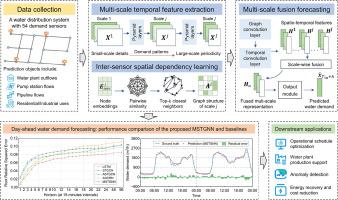基于多尺度时空图神经网络的水资源需求预测
IF 12.4
1区 环境科学与生态学
Q1 ENGINEERING, ENVIRONMENTAL
引用次数: 0
摘要
准确的需水量预测是有效管理供水系统的关键。图神经网络利用预先定义的空间图来建模传感器节点之间的关系,已广泛应用于WDF。现有方法通常在单个时间尺度上捕获时间依赖性,并构建代表最主要空间关系的静态图。这些限制通常会损害模型的性能,特别是在图形复杂性增加和预测范围扩大的情况下。为了解决上述问题,本研究提出了一种适合需水时间序列层次性的多尺度时空图神经网络(MSTGNN)。具体来说,MSTGNN通过构建从精细到粗糙的时间尺度的分层时间表示来捕获多尺度需求模式。此外,它自适应地学习特定于尺度的图结构,以反映不同尺度上丰富的传感器间依赖关系。在包含54个传感器的真实WDF数据集上进行的大量实验表明,MSTGNN在间隔15分钟的前一天WDF中取得了优于六种最先进方法的性能。它在多尺度时空依赖关系建模方面的优势显著提高了预测的准确性和可扩展性,为WDS中的高级智能应用提供了支持。本文章由计算机程序翻译,如有差异,请以英文原文为准。

Multi-Scale Spatio-Temporal Graph Neural Network for Enhanced Water Demand Forecasting
Accurate Water Demand Forecasting (WDF) is essential for effectively managing the Water Distribution System (WDS). Graph neural networks, which utilize pre-defined spatial graphs to model relationships among sensor nodes, have been widely applied to WDF. Existing methods typically capture temporal dependencies at a single time scale and construct static graphs representing the most dominant spatial relationships. These limitations often impair model performance, particularly under increased graph complexity and extended forecasting horizons. To address the above issues, this study proposes a Multi-scale Spatio-Temporal Graph Neural Network (MSTGNN) tailored to the hierarchical nature of water demand time series. Specifically, MSTGNN captures multi-scale demand patterns by constructing hierarchical temporal representations ranging from fine to coarse time scales. Moreover, it adaptively learns scale-specific graph structures to reflect rich inter-sensor dependencies varying across scales. Extensive experiments on a real-world WDF dataset with 54 sensors demonstrate that MSTGNN achieves superior performance over six state-of-the-art methods in day-ahead WDF at 15-minute intervals. Its strength in modeling multi-scale spatio-temporal dependencies significantly enhances forecasting accuracy and scalability, supporting advanced smart applications in WDS.
求助全文
通过发布文献求助,成功后即可免费获取论文全文。
去求助
来源期刊

Water Research
环境科学-工程:环境
CiteScore
20.80
自引率
9.40%
发文量
1307
审稿时长
38 days
期刊介绍:
Water Research, along with its open access companion journal Water Research X, serves as a platform for publishing original research papers covering various aspects of the science and technology related to the anthropogenic water cycle, water quality, and its management worldwide. The audience targeted by the journal comprises biologists, chemical engineers, chemists, civil engineers, environmental engineers, limnologists, and microbiologists. The scope of the journal include:
•Treatment processes for water and wastewaters (municipal, agricultural, industrial, and on-site treatment), including resource recovery and residuals management;
•Urban hydrology including sewer systems, stormwater management, and green infrastructure;
•Drinking water treatment and distribution;
•Potable and non-potable water reuse;
•Sanitation, public health, and risk assessment;
•Anaerobic digestion, solid and hazardous waste management, including source characterization and the effects and control of leachates and gaseous emissions;
•Contaminants (chemical, microbial, anthropogenic particles such as nanoparticles or microplastics) and related water quality sensing, monitoring, fate, and assessment;
•Anthropogenic impacts on inland, tidal, coastal and urban waters, focusing on surface and ground waters, and point and non-point sources of pollution;
•Environmental restoration, linked to surface water, groundwater and groundwater remediation;
•Analysis of the interfaces between sediments and water, and between water and atmosphere, focusing specifically on anthropogenic impacts;
•Mathematical modelling, systems analysis, machine learning, and beneficial use of big data related to the anthropogenic water cycle;
•Socio-economic, policy, and regulations studies.
 求助内容:
求助内容: 应助结果提醒方式:
应助结果提醒方式:


